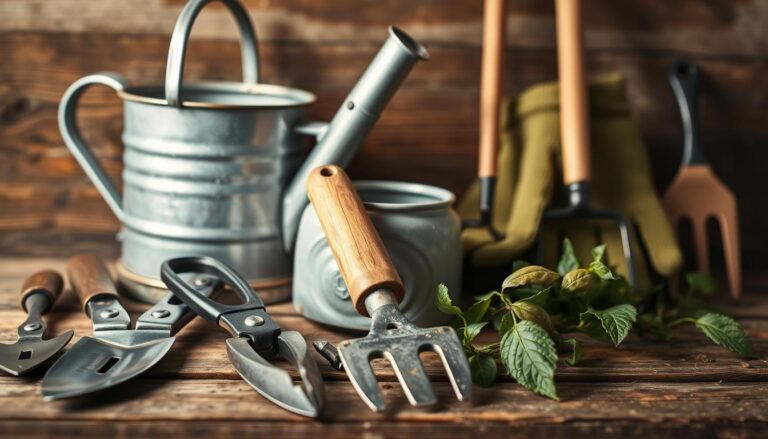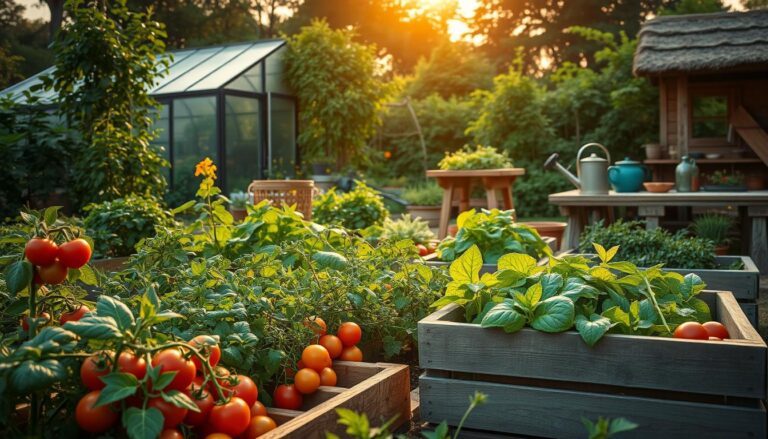Sunlight is vital for plants, helping them grow and thrive. It’s key for photosynthesis, where plants make their energy. Without enough sunlight, plants can weaken and get sick.
Not enough sunlight causes slow growth and poor health in plants. But, optimizing sunlight exposure can make plants stronger and more resilient.
Learning to use sunlight well is a big step towards a healthier garden. We’ll look at why sunlight matters and share tips to get it right.
The Science of Sunlight and Plant Growth
Sunlight is key for plant growth, affecting how well they grow and produce. Plants use sunlight as their main energy source for photosynthesis. This is how they make their food.
The Photosynthesis Process
Photosynthesis is a complex process. It turns light energy into chemical energy. This is vital for plant growth and development.
Light Energy Conversion
In photosynthesis, light energy is absorbed by chlorophyll and other pigments. It is then turned into ATP and NADPH. These molecules power the making of glucose and oxygen from carbon dioxide and water.
Carbon Dioxide Utilization
The energy from light helps turn carbon dioxide into organic compounds. These compounds, like glucose, are the building blocks for plant growth.
How Different Light Wavelengths Affect Plants
Different light wavelengths affect plant growth and development in different ways. Knowing these effects is key to optimizing sunlight for plants.
Blue Light Benefits
Blue light helps with vegetative growth and leaf development. It controls plant height and boosts chlorophyll production.
Red Light Effects
Red light affects flowering and fruiting. It’s important for plant development, especially during reproductive stages.
Understanding sunlight and plant growth helps gardeners optimize sunlight for their plants. This improves growth and productivity.
Identifying Your Plants’ Sunlight Requirements
To make your plants grow well, you need to know how much sunlight they need. Each plant is different when it comes to sunlight.
Categories of Light Requirements
Plants fall into three main groups based on sunlight needs:
- Full Sun Plants: These need 6 or more hours of direct sunlight every day.
- Partial Sun Plants: They do best with 3-6 hours of direct sunlight daily.
- Shade-Loving Plants: These prefer less than 3 hours of direct sunlight or indirect light all day.
Full Sun Plants (6+ hours)
Full sun plants come from sunny, dry places. Examples include cacti and many flowers.
Partial Sun Plants (3-6 hours)
Partial sun plants like a mix of direct and indirect sunlight. Many vegetables and herbs fit into this category.
Shade-Loving Plants (Less than 3 hours)
Shade-loving plants need low light and often do well in dappled or indirect sunlight.
Researching Specific Plant Needs
It’s important to find out what each plant in your garden needs. You can check the plant tag, gardening books, or online for this info.
Signs Your Plant Is Getting Improper Light
Plants show signs if they’re not getting the right light. Stretching towards the light or getting scorched means they’re getting too little or too much sunlight.
Assessing Your Growing Environment
Checking the sunlight in your garden or indoor space is key for healthy plants. You need to know the sunlight patterns in your area.
How to Map Sunlight Patterns
Mapping sunlight patterns means watching and recording the sunlight your plants get all day. There are two main ways to do this:
Daily Tracking Method
The daily tracking method is about watching and writing down sunlight patterns at different times. You can use a simple log or journal for this.
Using Sun-Tracking Apps
You can also use sun-tracking apps. These apps use your device’s location to show sunlight patterns. They tell you about the sun’s path and how strong it is all day.
Seasonal Variations in Light Exposure
Seasonal changes also affect sunlight. As the Earth moves, sunlight’s angle and strength change. This impacts how much light your plants get.
“The changing seasons bring about significant variations in sunlight, which can impact plant growth. Understanding these changes is crucial for maintaining optimal growing conditions.”
Identifying Light Obstacles and Shadows
It’s important to find and deal with light obstacles and shadows. Trees, buildings, and other things can block sunlight and cast shadows on your plants.
| Obstacle | Impact on Sunlight | Potential Solution |
|---|---|---|
| Trees | Cast shade, especially during peak sun hours | Prune branches or relocate plants |
| Buildings | Block sunlight, creating persistent shadows | Use reflective surfaces or adjust plant placement |
| Fencing | Can cast shadows, depending on orientation | Adjust fencing or use grow lights |
By understanding and fixing these issues, you can improve sunlight for your plants. This helps them grow healthier.
Optimizing Sunlight for Plant Growth: Core Techniques
To get plants to grow well, you need to place them right and use other tricks. It’s key to get the optimal sunlight levels for plant growth for their health.
Strategic Placement Strategies
Placing plants smartly means arranging them to catch the most sunlight. This needs careful planning and watching how they grow.
Height Arrangements for Light Sharing
Changing the height of plants or using stands helps share sunlight. Taller plants should not block sunlight from smaller ones.
Distance Calculations from Light Sources
Figuring out the right distance of plants from light is crucial. Being too close or far can harm plant growth.
| Plant Type | Optimal Distance from Light Source | Recommended Height |
|---|---|---|
| Seedlings | 6-12 inches | Low to Medium |
| Mature Plants | 1-3 feet | Medium to High |
Plant Rotation Schedules
Setting up a rotation schedule ensures all plants get sunlight. This is key for plants near windows or under grow lights.
Using Reflective Materials to Enhance Light
Reflective materials like aluminum foil or mulch spread sunlight evenly. This boosts light for all plants.
Managing Excessive Sunlight Exposure
Sunlight is key for plant growth, but too much can harm them. It can cause sunburn and heat stress. Plants need just the right amount of sunlight to grow well.
Recognizing Sunburn and Heat Stress
Too much sunlight can hurt plants, showing signs like sunburn and heat stress. Spotting these signs early is important to help your plants.
Leaf Discoloration Patterns
Leaf discoloration is a clear sign of sunburn. Leaves might turn yellow, white, or get spots. The exact look depends on the plant and how much sun it gets.
Growth Abnormalities
Excessive sunlight can also cause growth abnormalities. Plants might grow slowly or wilt. These signs show the plant is stressed from too much sun.
Temporary Shade Solutions
Temporary shade can help when sunlight is too strong. You can use shade cloth or natural barriers to block some sun.
DIY Shade Cloth Installation
Setting up a shade cloth is easy and works well. It lets you control how much sun your plants get.
Natural Barrier Creation
Using plants or other materials to block sun is also good. It protects your plants and makes your garden look better.
Hardening Off: Transitioning Plants to More Light
When moving plants to brighter spots, do it slowly. This helps them adjust to more sunlight without getting stressed. It’s a key step in helping plants grow well.
Gardening experts say, “Slowly getting plants used to more sunlight helps them grow better.” This method is vital for plants to thrive in sunlight.
Solutions for Light-Deprived Plants
Light-deprived plants can still grow well with the right help. They need enough sunlight to grow well. If they don’t get enough light, their growth slows down and they may get sick. Luckily, there are ways to help them get more light.
Pruning Techniques to Increase Light Penetration
Pruning is a simple way to make sure plants get enough light. By cutting off dead or dying leaves and branches, you help air move better. This lets more light reach the plant’s inner parts. It also helps the plant grow healthy.
Installing Reflectors and Light Shelves
Reflectors and light shelves are great for getting more sunlight to plants. They bounce sunlight onto plants that don’t get enough.
DIY Reflector Construction
Making a reflector is easy. Use cardboard or foam board covered with aluminum foil. Place it so it reflects sunlight onto the plants.
Optimal Placement Angles
Where you put the reflector matters a lot. It should reflect sunlight onto plants during the brightest hours. Try different angles to find the best spot.
Step-by-Step Plant Relocation Process
At times, the best thing is to move plants to a sunnier spot. Here’s how to do it right:
- Assess the New Location: Check if the new spot gets enough sunlight before moving the plants.
- Prepare the Plants: Water the plants a day before moving to reduce shock.
- Relocate: Move the plants carefully to their new spot, avoiding sudden changes.
- Monitor: Watch the plants closely after moving to make sure they adjust well.
| Technique | Description | Benefits |
|---|---|---|
| Pruning | Removing dead or dying leaves and branches | Improves air circulation and light penetration |
| Reflectors and Light Shelves | Redirecting sunlight onto plants | Enhances light exposure for plants in shaded areas |
| Relocation | Moving plants to a brighter location | Provides plants with the light they need to thrive |
Supplemental Lighting Systems
The right supplemental lighting can greatly improve plant health and growth. It makes up for when there’s not enough natural sunlight. These systems give plants the light they need for photosynthesis, especially in low-light areas.
Choosing the Right Grow Lights
Choosing the right grow lights is key for your plants’ health and growth. Each type of grow light has its own benefits.
LED vs. Fluorescent vs. HID Options
LED grow lights are energy-efficient and don’t get hot, making them great for plants. Fluorescent lights, like T5 and T8, are also good because they’re energy-efficient and have a wide spectrum. HID lights, such as HPS and MH, are very intense but can get hot.
Light Spectrum Considerations
Plants need different light spectra for the best growth. Blue light helps plants grow, while red light helps them flower and fruit. A balanced spectrum is best for overall health.
Setting Up Your Lighting System
Setting up your supplemental lighting system right is important for its best performance.
Height and Coverage Calculations
The height of your grow lights is crucial. Lights too close can overheat, while those too far away don’t light enough. Find the perfect height based on the light’s power and the plant’s needs.
Timer Installation and Programming
Using a timer helps plants get a steady light schedule, like natural daylight. This helps control their growth and development.
Creating an Optimal Light Schedule
Plants need different light amounts at different growth stages. A schedule that changes with these needs can really help their health and productivity. For example, seedlings need more light as they grow.
- Research the specific lighting needs of your plants.
- Adjust the duration and intensity of light according to the plant’s growth stage.
- Monitor plant response and adjust the lighting schedule as necessary.
Seasonal Adjustments for Year-Round Growth
To keep your plants thriving, it’s essential to make seasonal adjustments to their sunlight exposure. Different seasons bring varying sunlight patterns, affecting plant growth and health.
Winter Light Optimization Strategies
During winter, plants often suffer from insufficient light. Two key strategies can help optimize light exposure:
- Supplemental Lighting Timing: Using grow lights during the shortest days to supplement natural light.
- Window Cleaning and Maximization: Ensuring windows are clean and unobstructed to maximize natural light entry.
Summer Sun Management Techniques
Summer brings intense sunlight, which can be harmful if not managed properly. Techniques include:
- Heat Reduction Methods: Using shades or louvers to reduce heat stress on plants.
- Watering Adjustments for High Light: Adjusting watering schedules to compensate for increased evapotranspiration.
Seasonal Transition Planning
Transitioning plants between seasons requires careful planning. A key aspect is monitoring sunlight exposure and adjusting plant placement accordingly.
| Season | Sunlight Characteristics | Adjustment Strategies |
|---|---|---|
| Winter | Low intensity, short duration | Supplemental lighting, window cleaning |
| Summer | High intensity, long duration | Shading, adjusted watering |
Maximizing Mobility: Container Gardening Light Strategies
Container gardening is a great way to get the most sunlight for your plants. You can move your containers to find the best spot for sunlight.
Selecting Containers for Light Optimization
Picking the right containers is key for getting more sunlight. Light-colored containers bounce sunlight onto your plants. On the other hand, dark-colored containers soak up heat, which is good in cool places but not in warm ones.
Creating a Mobile Garden System
A mobile garden system lets you move plants to get more sunlight. You can do this in a few ways:
- Wheeled platforms for easy movement
- Lightweight container alternatives
Wheeled Platform Options
Wheeled platforms or dollies help move big containers without straining. They’re great for big plants or if you have trouble moving around.
Lightweight Container Alternatives
Light containers, like plastic or fiberglass, are easy to move. They’re also strong and can handle different weather.
Best Practices for Moving Plants Safely
When you move plants, do it carefully to avoid harming the roots or soil. Here’s how:
| Precaution | Benefit |
|---|---|
| Water plants before moving | Reduces soil disturbance |
| Handle containers by the base | Prevents tipping over |
| Move plants during cooler parts of the day | Reduces stress on plants |
Indoor Plant Light Optimization Techniques
Improving plant growth indoors starts with better sunlight. Plants need specific light to stay healthy and strong.
Window Direction Light Quality Guide
The direction of your windows affects the light your plants get. Knowing this helps you place plants right.
South-Facing Windows
South-facing windows get the most sunlight. They’re perfect for plants needing lots of light, like succulents and cacti. Plants like aloe vera and succulent species do well here.
East, West, and North Exposures
East windows offer gentle morning light, good for plants that like soft light. West windows have strong afternoon sun, which can be tough for some. North windows get the least sunlight, ideal for plants like Chinese Evergreen and Pothos.
Maximizing Natural Light Indoors
Getting more natural light indoors is more than just putting plants by windows. It’s about planning to make sure plants get the right light.
Strategic Mirror Placement
Putting mirrors opposite windows can bounce light further into the room. This helps plants farther from the window get more light.
Glass Shelf Installation
Adding glass shelves near windows lets you put more plants in the best light spot. It saves space and makes sure more plants get enough light.
Window Treatment Adjustments for Plant Health
Changing your window treatments can also change the light your plants get. Sheer curtains soften strong light, and removing things can let in more light.
With these tips, you can make a great light spot for your indoor plants. This will help them grow better and stay healthy.
Troubleshooting Common Sunlight Problems
Fixing sunlight issues is key for healthy plants. Plants can get too little or too much sun, causing problems like etiolation or leaf burn.
Diagnosing Light-Related Plant Issues
It’s important to figure out the right fix for sunlight problems. Common issues include etiolation (stretching) and leaf burn.
Etiolation (Stretching) Solutions
Etiolation happens when plants stretch for more light. Moving plants to a brighter spot or using grow lights can solve this.
Leaf Burn Recovery Techniques
Leaf burn is caused by too much sun. Shading or moving plants can help fix this.
Adjusting for Changing Light Conditions
Light patterns change with the seasons. It’s important to check and adjust your plants’ light often.
Using Light Meters Effectively
A light meter helps measure sun intensity. Using this tool ensures your plants get the right amount of light.
Gardening experts say, “Knowing and adjusting to your plants’ light needs is crucial for their health and growth.” –
A quote from a renowned horticulturist highlights the importance of proper sunlight for plant development.
Conclusion
Getting the right amount of sunlight is key for healthy plants. Knowing what your plants need and where to place them can really help. This way, they grow better and stay healthy.
There are many ways to make sure plants get the right sunlight. You can move them around, use mirrors, or add extra lights. If the sunlight is too strong or weak, you can use shades or trim them.
By using these methods and watching the seasons, you can make a great spot for your plants. This will make them stronger and more colorful. It’s all about giving them the best chance to grow.
Managing sunlight well is important for your plants to reach their full potential. It ensures they get the sunlight they need to stay healthy and strong.
FAQ
What is the ideal sunlight intensity for plants?
How do I determine the sunlight requirements for my plants?
Can I use grow lights to supplement natural sunlight?
How can I optimize sunlight for my indoor plants?
What are the signs of too much or too little sunlight for plants?
How can I maximize plant growth with proper sunlight?
Can I move my plants outside during the summer months?
How do I care for my plants during the winter months when sunlight is scarce?

Sortemdia nasceu com o propósito de trazer alegria e oportunidades para todos por meio de sorteios gratuitos de prêmios incríveis. O site tem como missão oferecer experiências acessíveis, divertidas e justas para quem deseja concorrer a produtos, serviços e brindes sem pagar nada por isso. Acreditamos que a sorte pode bater à porta de qualquer pessoa — e no Sortemdia, ela pode chegar com apenas um clique.



